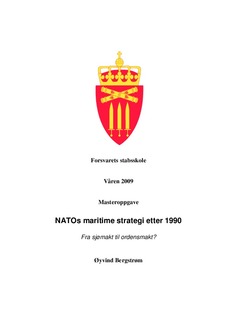NATOs maritime strategi etter 1990: Fra sjømakt til ordensmakt?
Master thesis
Permanent lenke
http://hdl.handle.net/11250/99840Utgivelsesdato
2009Metadata
Vis full innførselSamlinger
- Masteroppgaver [450]
Sammendrag
In this thesis I have studied NATO’s maritime strategy after the Cold War. My main focus has been to compare the strategic guidelines provided by the Alliance’s strategic concepts and its Summits with the operational use of the Alliance Standing Naval Forces. I have looked into contemporary work in the Alliance on concept and strategy development covering today’s maritime operations, and finally analysed the implications for perceived Norwegian security issues related to high north. The study’s is based mainly on empirical data from NATOs official documents and interviews with Norwegian naval officers with former or present experience from NATO headquarters or NATO Standing Naval Forces. The conclusions I reach are as follows: During the last 20 years the role of NATO’s maritime forces has changed from primarily being war fighting, via naval diplomacy, to good order at sea. On the whole, there seems to be consistency between overall policy and the activity of the Alliance naval forces. However, there are signs especially during the last couple of years of internal disagreement with regard to the primary role of the maritime forces. It also seems as the development of doctrine and concepts covering the new role of the maritime forces, is progressing too slowly, causing a doctrinal and conceptual vacuum for the forces performing their new missions. Both the latest U.S. maritime strategy and the work undertaken by NATOs Multiple Futures Project seem to point in the same direction for the future peacetime role of NATO’s maritime forces: Good order at sea. While this role fits Norwegian security issues in the high north well, there is little evidence this region will be on the top of the Alliance’s maritime agenda for the years to come.
